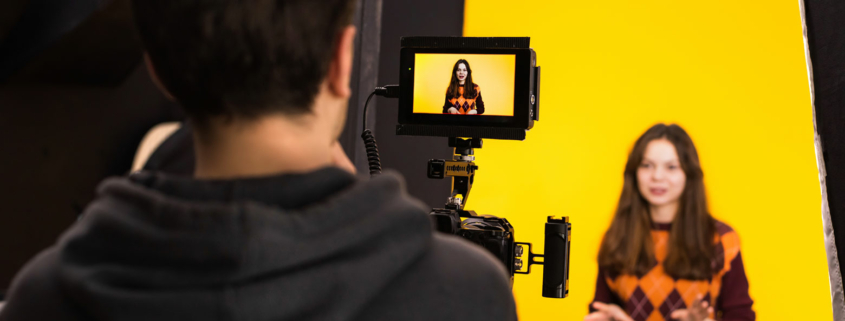Behind the Scenes: Pulling Back the Curtain of Influencer Marketing
How many times have you scrolled through your social media feeds and stopped on an influencer’s post promoting a product or service? That’s the power of influencer marketing.
The rise in popularity of influencers has made them invaluable to businesses looking for ways to engage with their customers and increase brand awareness. Understanding exactly who a successful influencer is often comes with many questions. If you find yourself scratching your head and wondering just what makes an influencer good at their job, or if they’re right for your brand, never fear – we’ve got those answers and more right here.
What’s Influencer Marketing?
Influencer marketing is like when the popular girl in high school gets everyone to want what she has. Except instead of it being some girl in your math class, it’s someone you’ve never (typically) met. Social media influencers are the queens and kings of this realm. They’ve got large followings on social media platforms that hang onto their every post and snap, making them the perfect vehicle for brand awareness. They’re seen as thought leaders, as experts in a niche market.
Their opinion, whether it’s a blogger writing a guest entry on your site or a video/photo with your product on an Instagram post, can sway potential customers into making a purchase or simply even by attracting a new audience.
Think about it: if you saw your favorite social influencer raving about a new product, you’d probably be interested in checking it out yourself. That’s the power of influencer marketing. It’s like having a cool friend who can make things happen. And who doesn’t want one of those?
With Influencer Marketing, Size Matters
You need to know the different levels of social media influencers. Depending on their number of followers on certain social media platforms, you may (or may not) want to team up with them.
- Nano-Influencers: 1,000 to 10,000 followers
- Micro-Influencers: 10,000 to 15,000 followers
- Mid-Tier Influencers: 50,000 to 500,000 followers
- Macro-Influencers: 500,000 to 1,000,000 followers
- Mega-Influencers: 1,000,000+ followers
Before you start putting together your influencer marketing strategy, you need to do a deep dive into their followers. Does the mega-influencer you have your eye on even have the right follower demographic that aligns with your brand’s target audience? Just because a celebrity influencer has 3,000,000 followers doesn’t mean they’re the right type of influencer. Sometimes smaller gets the job done right.
Do Your Homework
When you’re creating your buyer personas and looking at your target audience, get familiar with the types of accounts and influencers your potential and established customers are following. You can track what your target audience follows by searching for hashtags.
Only team up with a nano-influencer or micro-influencer if their followers and type of content match your brand.
Celebrities vs. Influencers
Celebrities are actors, singers, models, etc., who have a following of people who enjoy watching them do what they do. On the other hand, social media influencers are people who have knowledge or interest in a specific subject.
Influencers have an heir of celebrity status to them, but don’t let it fool you. There’s a blurry line, but there is a difference.
Let’s look at Selena Gomez. She’s a singer and actress but is also considered an influencer, not only because of her followers, but because of her high level of engagement rate. She inspires her followers to embrace themselves as they are, sharing her journey with mental illness and lupus, and launching an inclusive skincare line.
Using her celebrity status to cross over to social media and turn that into an empire is part of her business strategy. It was reported that in 2022, Gomez raked in over a whopping $1.8 million per post. She has a crap ton of followers who look at her content, like it, then comment on it.
Addison Rae is an influencer who rose to TikTok fame on the platform by lip-syncing and dancing to music. But wait, there’s more. Remember earlier how we said social media marketing is like having a cool, popular friend? Rae’s bff is none other than Kourtney Kardashian.
Throwback to the Romans
The concept of influencer marketing campaigns using celebrity status isn’t new. Fun fact – the first celebrity endorsements date back to the Ancient Romans. How? Roman gladiators would promote fine wines and oils to their fans. Through the years, researchers have found evidence of this through wall graffiti and even ancient billboards, which were placed around Rome.
Pricing for Social Media Influencers
There are different types of payment in influencer marketing. Usually, content creators have a rate, and compensation depends on the social platform.
Instagram influencers, for example, typically charge around $10 per post for each 1,000 followers, while TikTok folks charge $25. But… how much should you pay? Use the following as a starting point, because we all have to start somewhere.
- Nano-Influencers: $10 to $100/post
- Micro-Influencers: $100 to $500/post
- Mid-Tier Influencers: $500 to $5,000/post
- Macro-Influencers: $5,000 to $10,000/post
- Mega-Influencers: $10,000+/post
Smaller influencers may do some content creation, like a product review, in exchange for that product.
According to Influencer Marketing Hub, projected influencer marketing is expected to grow to more than $21 billion in 2023. That figure is 29% higher than 2022, which was $16.4 billion. If you haven’t already, you should really consider adding influencer marketing to your digital marketing strategy.
Now it’s Time to Find Influencers
Are you ready to find the perfect partnership? Get ready for more homework.
Sometimes it’s as simple as reaching out after you check out their follower count and influencer content.
There’s also turning to influencer marketing agencies and platforms. Here’s where it gets fun for those giddy about technology – Lionize is an influencer marketing platform that uses AI to help you find the best influencers (and the right influencers). Influencers apply and relay their rates for influencer posts. Another popular influencer marketing platform is Upfluence, which sees a lot of traffic with ecommerce and direct-to-consumer brands.
What Makes a Successful Influencer
Measuring a successful influencer is easy. It comes down to the return on investment.
They’re leaders in their niche (which is your niche or tied to it somehow), they’ve got a social media strategy complete with content marketing (like blogging or videos), and their metrics back it up. The bottom line is you have a good influencer if their engagement rate is solid and there are conversions, meaning sales of your product or service.
Let Lift Bring You to Influencers
We get it – all this talk about how influencer marketing works can be time-consuming and overwhelming. That’s why you call the Lift Marketing team. No matter the form of marketing, we’re here to help you use marketing tools to the fullest capabilities while staying within your marketing budget.
Why are you still waiting? Drop us a line and we’ll introduce you to the influencer marketing industry.




